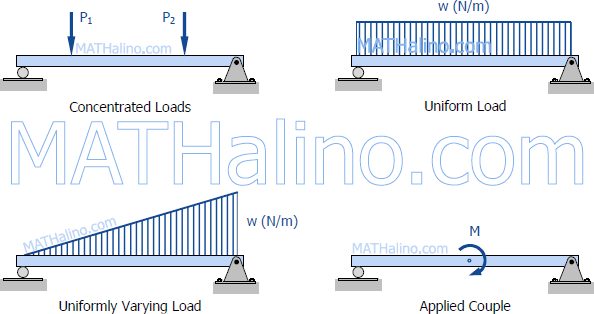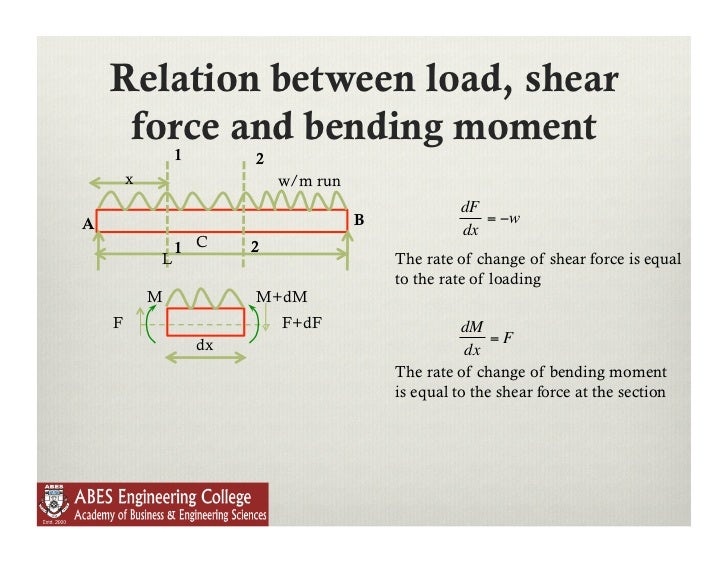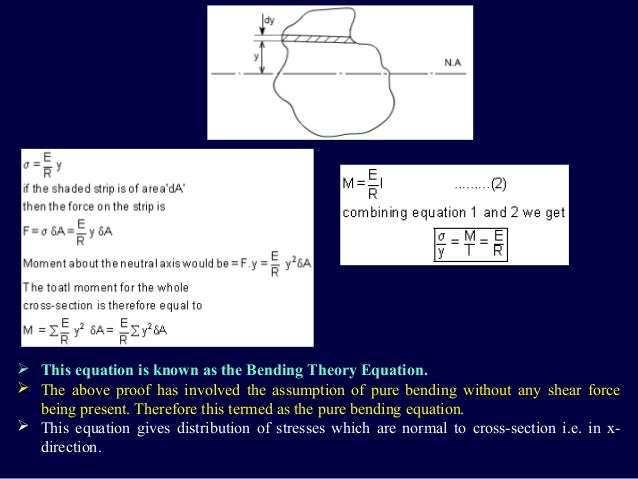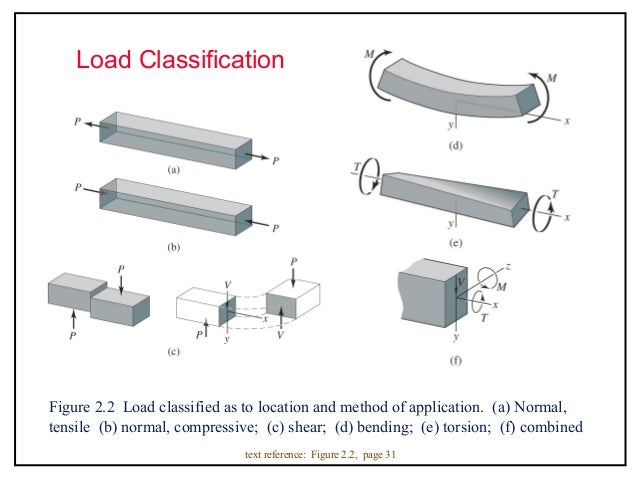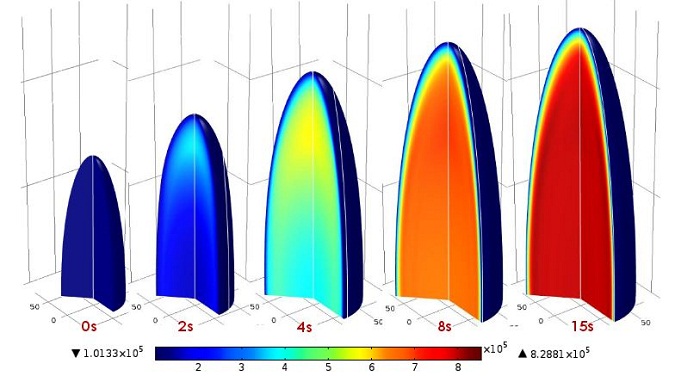This year 2017 is going to be full of fun and mathematics! :)
Thursday, 29 December 2016
Friday, 18 November 2016
15 days ahead.
this is more or less like a test to myself, i'm gonna post what exactly did i do in the coming 15 days. - the greatest programmer of all time
here are the thing what i have in mind :
i'm gonna draw
i'm gonna program
i'm gonna write
i'm gonna think
here are the thing what i have in mind :
i'm gonna draw
i'm gonna program
i'm gonna write
i'm gonna think
Monday, 17 October 2016
Mechanics..
Mechanics, especially solid mechanics. this post can be considered a mini primer on solid mechanics. i'm gonna cover most of the fundamental theories in plain english (Occasional math). okay, let's wait no more. let's get started...you can google what solid mechanics is and where it's used yourself.
here we go.
1 - Stresses and Strains
1.1 - What is stress? it's just force per unit area.
1.2 - What is strain?
1.3 - Stress Strain relationship? Hooke's law
1.4 - Axially loaded bars?
1.5 - Compound bars?
1.6 - Thermal stresses?
1.7 - Principal Stresses and Strains :
1.8 - Biaxial stress :
1.9 - Mohrs Circle : to understand this, you gonna need some mathematical background.
2 - Analysis of Beams :
2.1 - Shear force and bending moment :
2.2 - types of beams :
2.3 - Types of Loads :
2.4 - Shear force and bending moment diagrams :
2.5 - Relation between shear force and bending moments :
2.6 - Theory of simple bending :
2.8 - Bending Stress in beams :
2.9 - Shear Stress :
we use bending stress and shear stress to find stress distributions for various cross sections and shapes. more on that in future.
3 - Deflection of Beams :
3.1 - Slope and deflection of beams :
well that's all there is to know about slope and deflection. Most of the deflection theory lies in mathematics and simple algebra. Some of the notable methods for solving deflection and slope are double integration method, moment area method, strain energy method.
4 - Torsion of Circular Shafts :
4.1 - Theory of Pure torsion :
4.2 - some concepts :
4.3 - Springs :
we study stresses, deformations, axial loads and torque acting on springs.
4.4 - Thin Cylinders :
4.5 - Columns and Struts :
Some interesting images :
Note : Unfortunately, i didn't cite my sources for any of the images i've used. anyone interested can always left click on the image for the image link and its source.
I would like to end this post by saying a few things, most of the above concepts are pretty rudimentary, these are like the nuts and bolts of solid mechanics. Have a good time!
here we go.
1 - Stresses and Strains
1.1 - What is stress? it's just force per unit area.
1.2 - What is strain?
1.4 - Axially loaded bars?
1.5 - Compound bars?
1.6 - Thermal stresses?
1.7 - Principal Stresses and Strains :
2.1 - Shear force and bending moment :
2.3 - Types of Loads :
2.4 - Shear force and bending moment diagrams :
2.6 - Theory of simple bending :
2.8 - Bending Stress in beams :
we use bending stress and shear stress to find stress distributions for various cross sections and shapes. more on that in future.
3 - Deflection of Beams :
3.1 - Slope and deflection of beams :
well that's all there is to know about slope and deflection. Most of the deflection theory lies in mathematics and simple algebra. Some of the notable methods for solving deflection and slope are double integration method, moment area method, strain energy method.
4 - Torsion of Circular Shafts :
4.1 - Theory of Pure torsion :
4.2 - some concepts :
4.3 - Springs :
we study stresses, deformations, axial loads and torque acting on springs.
4.4 - Thin Cylinders :
4.5 - Columns and Struts :
Some interesting images :
Note : Unfortunately, i didn't cite my sources for any of the images i've used. anyone interested can always left click on the image for the image link and its source.
I would like to end this post by saying a few things, most of the above concepts are pretty rudimentary, these are like the nuts and bolts of solid mechanics. Have a good time!
Sunday, 9 October 2016
In the last two months....
time flies! project image is a total disaster, but i did a little project on it though which was more or less half assed work. the project is based on Optical character recognition. Which basically means, it converts the pixels in a image into meaningful data using a predefined database, in simple words: if you take a snapshot of a textbook, it'll convert it into text and then you can save it as a pdf file. i've also learned a little on fourier transforms and how images can be deconstructed into primitive data and then that data can be used to do some cool stuff. and basically, that's it for the project image.
now, here's what i did in the past 2 months : i've tried many many many fucking things, everyday i used think of something new i want to accomplish. ( well didn't really accomplish much ), saw some beautiful movies. i planned on becoming good at a Object Oriented programming language by january the coming year ( 2017 ), i had a trouble choosing something.. and i finally chose java over everything else. In life, "Knowing you still have possibilities is a luxury". I even planned on starting a business related to information distribution ( facts ) about two months ago, i still haven't did shit about it. I've read some pretty good stuff, watched a hell lot of documentaries. of all the things, things that are most memorable are : Flight without formulae - Ac Kermode, this book is so good, even a layman who has an iq of 60 can understand how flights work. Read some stuff here and there on aerodynamics, for a brief period i even considered on becoming a aerodynamicist. after reading flight without formulaes, i had these visions of future where flight mechanics and the technology is so advanced, it's hard for us to comprehend right now with our primitive technology and ideas. and then i started reading Introduction to algorithms - CLRS, read first chapter, had a lot of difficulty understanding psuedo codes, cause i've never dealt with them before. then i read the first two or three chapters in Schaums Datastructures. then i realized, software runs the world. i never thought software was used on such grand scale. few days on and off from these subjects. then i wanted to do get a great internship at fortune 500 companies or something like that. and then i don't even remember putting much effort in searching. also for a brief period, i even tried data science and analytics, did learn a bit of R programming. then one day i had visions of becoming a NASA engineer and sending humans to mars and doing all kind of sciency stuff and becoming a rocket propulsioni engineer. well, i have to say that didn't work much either. of all the books i've read, i've enjoyed flowers for algernon alot. and here i am, bored as fuck with life, waiting to explore the unexplored. i don't even remember much of what i learned, just faded images are all i can see in mind......life is a total mystery, has no meaning, no purpose.
now, here's what i did in the past 2 months : i've tried many many many fucking things, everyday i used think of something new i want to accomplish. ( well didn't really accomplish much ), saw some beautiful movies. i planned on becoming good at a Object Oriented programming language by january the coming year ( 2017 ), i had a trouble choosing something.. and i finally chose java over everything else. In life, "Knowing you still have possibilities is a luxury". I even planned on starting a business related to information distribution ( facts ) about two months ago, i still haven't did shit about it. I've read some pretty good stuff, watched a hell lot of documentaries. of all the things, things that are most memorable are : Flight without formulae - Ac Kermode, this book is so good, even a layman who has an iq of 60 can understand how flights work. Read some stuff here and there on aerodynamics, for a brief period i even considered on becoming a aerodynamicist. after reading flight without formulaes, i had these visions of future where flight mechanics and the technology is so advanced, it's hard for us to comprehend right now with our primitive technology and ideas. and then i started reading Introduction to algorithms - CLRS, read first chapter, had a lot of difficulty understanding psuedo codes, cause i've never dealt with them before. then i read the first two or three chapters in Schaums Datastructures. then i realized, software runs the world. i never thought software was used on such grand scale. few days on and off from these subjects. then i wanted to do get a great internship at fortune 500 companies or something like that. and then i don't even remember putting much effort in searching. also for a brief period, i even tried data science and analytics, did learn a bit of R programming. then one day i had visions of becoming a NASA engineer and sending humans to mars and doing all kind of sciency stuff and becoming a rocket propulsioni engineer. well, i have to say that didn't work much either. of all the books i've read, i've enjoyed flowers for algernon alot. and here i am, bored as fuck with life, waiting to explore the unexplored. i don't even remember much of what i learned, just faded images are all i can see in mind......life is a total mystery, has no meaning, no purpose.
"THIS TOO SHALL PASS"
Saturday, 30 July 2016
Alkaline Batteries
We all have seen these batteries atleast once in our lifetimes. so we'll discuss some science behind these batteries ( these batteries are known as alkaline batteries ). Alkaline batteries are the most manufactured batteries.
Anything with a Ph level over 7 is called alkaline. So these batteries get their name from the Potassium Hydroxide electrolyte present inside. This is how Potassium Hydroxide looks like. Electrolyte of Potassium Hydroxide is present in Alkaline battery.
Basic chemistry inside the battery :
Electrodes are something through which electricity enters or leaves.
there are two electrodes : Positive electrode - manganese (IV) oxide
Negative electrode - Zinc
Zinc :
Manganese Dioxide :
Detailed image showing which is where :
You may wonder about the voltage. voltage in a battery is genereted by chemical reactions inside the battery.
We'll discuss more concepts relating to batteries and energy storage in future posts......
Anything with a Ph level over 7 is called alkaline. So these batteries get their name from the Potassium Hydroxide electrolyte present inside. This is how Potassium Hydroxide looks like. Electrolyte of Potassium Hydroxide is present in Alkaline battery.
Basic chemistry inside the battery :
Electrodes are something through which electricity enters or leaves.
there are two electrodes : Positive electrode - manganese (IV) oxide
Negative electrode - Zinc
Zinc :
Manganese Dioxide :
Detailed image showing which is where :
You may wonder about the voltage. voltage in a battery is genereted by chemical reactions inside the battery.
The half-reactions are:
- Zn(s) + 2OH−(aq) → ZnO(s) + H2O(l) + 2e− [e° = -1.28 V]
- 2MnO2(s) + H2O(l) + 2e− → Mn2O3(s) + 2OH−(aq) [e° = +0.15 V]
Overall reaction:
- Zn(s) + 2MnO2(s) ⇌ ZnO(s) + Mn2O3(s) [e° = +1.43 V]
We'll discuss more concepts relating to batteries and energy storage in future posts......
Friday, 29 July 2016
Thermal Imaging
What you are seeing on the right is a picture of a dog under thermal camera. As you see bright yellow areas are of high temperature and blue areas are of low temperature.
How does one capture a thermal image? there is some interesting science behind everything that goes on the screen.
Anything ( living, non-living ) which has a temperature above 0 Kelvin ( -273.15 deg C ) emits radiation. Radiation is the emission of energy. Thermal cameras form images by detecting Infrared. Infrared is a part of Electromagnetic spectrum. What we see is Visible light which is also a part of electromagnetic spectrum.
You can see the electromagnetic spectrum below.
 Infrared means below red. Infrared is discovered by Sir William Herschel in 1800.
Infrared means below red. Infrared is discovered by Sir William Herschel in 1800.
Thermal images are measure of energies emitted, transmitted and reflected by the object.
the sum of Emitted Energy, Transmitted energy and Reflected energy is always equals to 1.
Any object has emittance less than 1. Emmisivity can be defined as the ratio of energy radiated from a material surface to that of blackbody under the same conditions (or) simply the measure of radiation emitted by the object. A good emitter is a good absorber of energy. In the below table you can see emissivity of some metals and non-metals.
Reflectance is the amount of light or radiation reflecting off the object. As you can see low emissivity materials have high reflectance. where as high emissivity materials have low reflectance.
Transmittance is the ratio of light falling and light transmitted through the object.
Now you can understand why the sum of Reflectance,Transmittance and Emittance Energies is equals to one.
Blackbody Radiation : As we have seen above, Emissivity is the ratio of the radiation emitted by the object to that of blackbody at same conditions. Blackbody is something which absorbs all types of Electromagnetic radiation. Blackbody is an ideal body ( cannot be found in nature ). Blackbody emits radiation at thermal equilibrium and it is known as Blackbody radiation.
Kirchoff's Law : when an object is in thermal equilibrium. absoroption = emission. basically you can say, when an object is at the same temperature as that of surroundings. its said to be in thermal equilibrium.
Stefan-Boltzmann Law : relation between tempearture and power radiated. Or simply hot bodies emit more IR energy. Cold bodies emit less IR energy.
Wien's Displacement Law : Wavelength at which maximum energy is emitted decreases with increasing temperature.
Planck Radiation Law : relation between wavelength, temperature and intensity of radiation.
These are the basic principles usually used in thermal imaging. here are some interesting thermal images :
How does one capture a thermal image? there is some interesting science behind everything that goes on the screen.
Anything ( living, non-living ) which has a temperature above 0 Kelvin ( -273.15 deg C ) emits radiation. Radiation is the emission of energy. Thermal cameras form images by detecting Infrared. Infrared is a part of Electromagnetic spectrum. What we see is Visible light which is also a part of electromagnetic spectrum.
You can see the electromagnetic spectrum below.
 Infrared means below red. Infrared is discovered by Sir William Herschel in 1800.
Infrared means below red. Infrared is discovered by Sir William Herschel in 1800.Thermal images are measure of energies emitted, transmitted and reflected by the object.
the sum of Emitted Energy, Transmitted energy and Reflected energy is always equals to 1.
Any object has emittance less than 1. Emmisivity can be defined as the ratio of energy radiated from a material surface to that of blackbody under the same conditions (or) simply the measure of radiation emitted by the object. A good emitter is a good absorber of energy. In the below table you can see emissivity of some metals and non-metals.
Reflectance is the amount of light or radiation reflecting off the object. As you can see low emissivity materials have high reflectance. where as high emissivity materials have low reflectance.
Transmittance is the ratio of light falling and light transmitted through the object.
Now you can understand why the sum of Reflectance,Transmittance and Emittance Energies is equals to one.
Blackbody Radiation : As we have seen above, Emissivity is the ratio of the radiation emitted by the object to that of blackbody at same conditions. Blackbody is something which absorbs all types of Electromagnetic radiation. Blackbody is an ideal body ( cannot be found in nature ). Blackbody emits radiation at thermal equilibrium and it is known as Blackbody radiation.
Kirchoff's Law : when an object is in thermal equilibrium. absoroption = emission. basically you can say, when an object is at the same temperature as that of surroundings. its said to be in thermal equilibrium.
Stefan-Boltzmann Law : relation between tempearture and power radiated. Or simply hot bodies emit more IR energy. Cold bodies emit less IR energy.
Wien's Displacement Law : Wavelength at which maximum energy is emitted decreases with increasing temperature.
Planck Radiation Law : relation between wavelength, temperature and intensity of radiation.
These are the basic principles usually used in thermal imaging. here are some interesting thermal images :
Subscribe to:
Posts (Atom)















